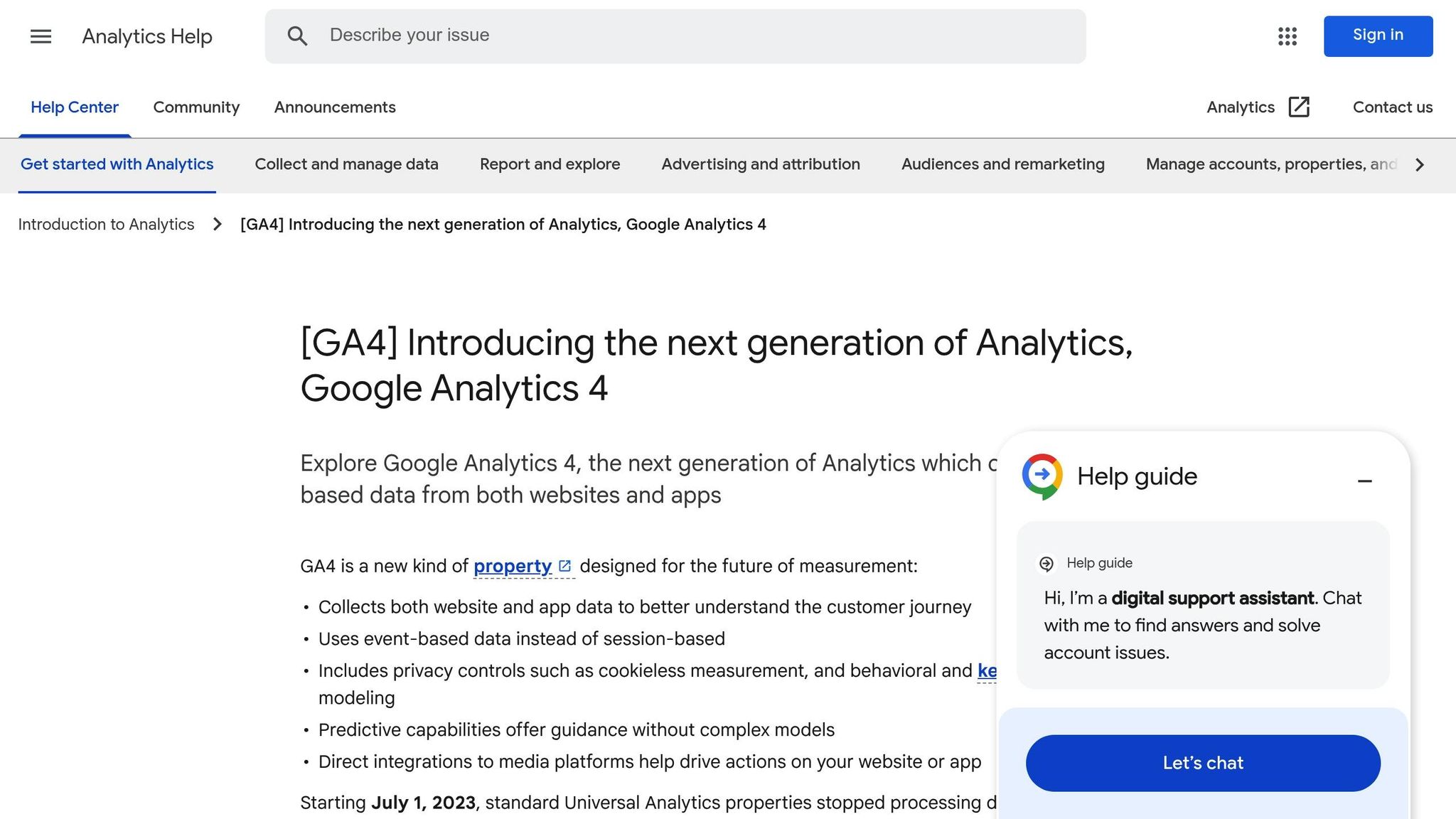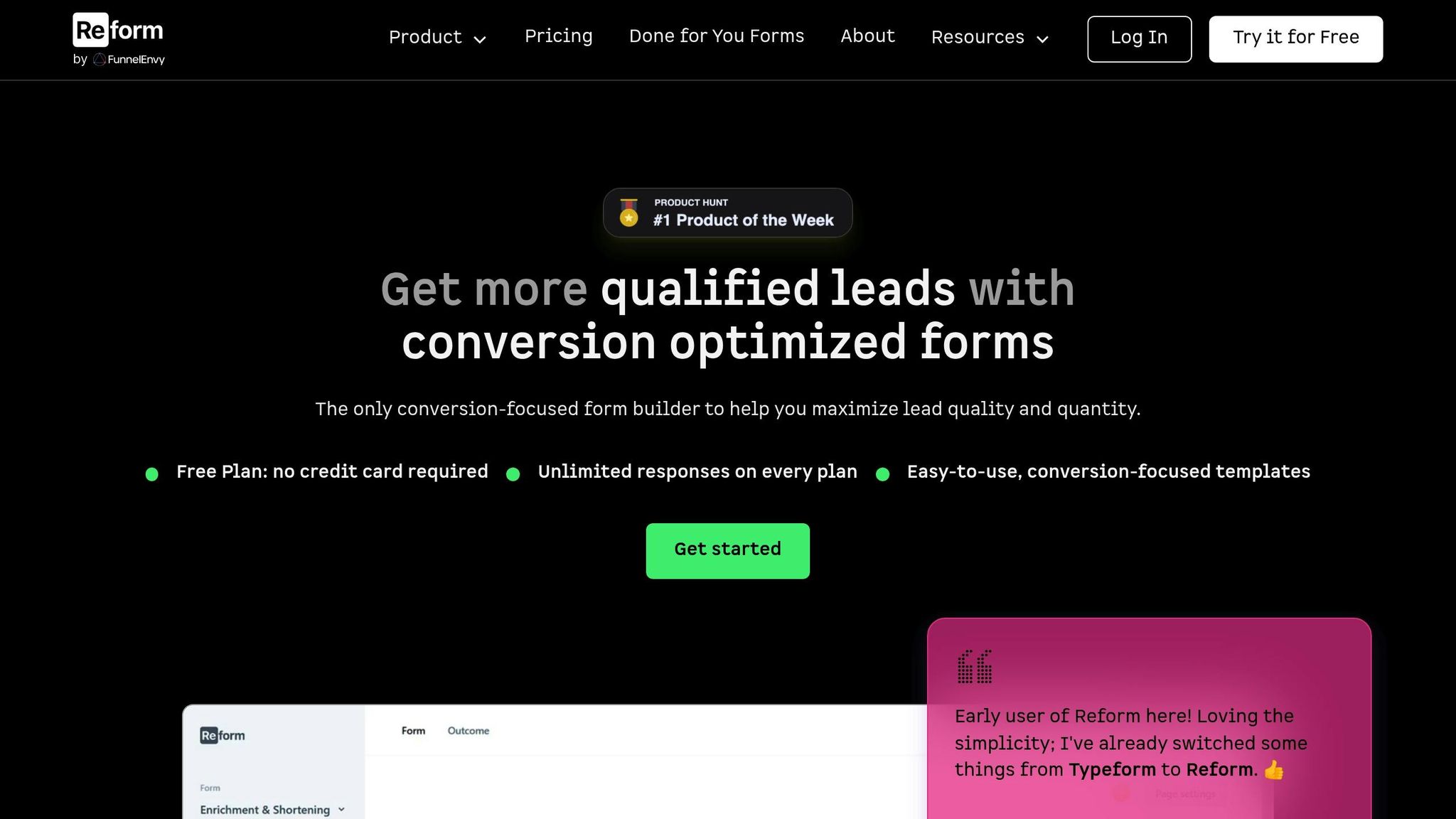Real-Time Analytics and GDPR Compliance

Real-time analytics helps businesses make quick decisions by analyzing user behavior. But when handling data from EU citizens, it must comply with GDPR. This includes securing explicit consent, limiting data collection, and managing cross-border transfers.
Key Takeaways:
- Google Analytics 4 (GA4): Offers tools like Consent Mode and data minimization but has faced legal challenges in the EU.
- Reform: A simpler, privacy-first form builder designed to meet GDPR standards with minimal configuration.
Quick Comparison:
| Criteria | Google Analytics 4 | Reform |
|---|---|---|
| Consent Management | Advanced consent tools | Built-in, easy-to-use options |
| Data Minimization | Manual setup required | Automatic, form-based controls |
| Ease of Use | Requires technical expertise | No-code, user-friendly |
| Target Use Case | Website and app analytics | Form-based data collection |
| Cost | Free tier; GA360 for advanced | Starts at $15/month |
Bottom Line:
Choose GA4 for detailed website analytics if you have technical resources. Opt for Reform if you need a straightforward, GDPR-compliant form solution.
How Do You Make Google Analytics Compliant With GDPR And CCPA? - Marketing and Advertising Guru
1. Google Analytics 4

Google Analytics 4 (GA4) is Google's latest tool designed to balance GDPR compliance with the need for real-time analytics. It introduces several privacy-focused features aimed at addressing the challenges of GDPR while still delivering actionable insights. Let’s break down its key components and how they align with GDPR requirements.
Consent Management
At the heart of GA4's GDPR compliance efforts is Consent Mode, which helps manage user permissions in accordance with GDPR guidelines. This system uses four consent types: analytics_storage (for analytics data), ad_storage (for advertising), ad_user_data, and ad_personalization. If a user denies consent, GA4 adjusts its behavior by avoiding cookie storage and instead sends cookieless pings to Google servers. These pings allow for data modeling without violating user preferences.
Consent Mode v2 became mandatory for EU users in March 2024. With this update, businesses must secure explicit, informed, and freely given opt-in consent before deploying non-essential cookies or tracking technologies for EU/EEA residents. Additionally, the process for withdrawing consent must be as straightforward as providing it, and organizations are required to securely document all user consent decisions.
GA4 also incorporates data minimization practices to further align with GDPR principles.
Data Minimization
GA4 offers configurable data retention settings to ensure that personal data isn’t stored longer than necessary. For standard GA4 accounts, user-level and event-level data can be retained for either 2 or 14 months, while GA4 360 accounts allow for retention periods of up to 50 months. Additionally, businesses can disable the collection of detailed location and device data, further limiting the amount of personal information processed.
Data Subject Rights
GA4 supports several rights outlined in GDPR, including the "right to be forgotten." The platform provides tools for deleting user data upon request. However, businesses are responsible for creating their own processes to handle additional data subject rights, such as access, rectification, and portability requests. GA4’s role is limited to offering the technical capability to delete data, leaving the implementation of broader GDPR obligations up to the organization.
GA4 also addresses the complexities of cross-border data transfers.
Data Transfer Safeguards
Transferring data between the EU and the US remains one of the trickiest aspects of GDPR compliance for GA4 users. The 2023 EU-U.S. Data Privacy Framework (commonly referred to as Privacy Shield 2.0) aims to simplify these transfers. GA4 incorporates safeguards like Data Processing Agreements (DPAs) and Standard Contractual Clauses (SCCs) with Google to ensure compliance. Additionally, businesses can use server-side tagging to customize and control tag behaviors, reducing the risk of unauthorized data use.
However, it’s worth noting that Data Protection Authorities in countries like Austria, Denmark, France, Italy, Norway, Sweden, and the Netherlands have previously ruled against Google Analytics. These rulings highlight that technical updates alone may not guarantee compliance. Organizations must carefully assess their own use cases and risk tolerance when relying on GA4 for analytics.
2. Reform

Reform provides a no-code form builder that prioritizes privacy and real-time analytics. It equips businesses with tools like opt-in consent and conditional routing, ensuring their data collection processes align with GDPR guidelines.
Consent Management
Reform offers detailed consent controls within its user-friendly interface, making GDPR-compliant data collection straightforward. With its conditional routing feature, forms dynamically adjust based on individual privacy preferences. For example, if a user opts out of specific data processing, the form automatically modifies itself to gather only the necessary information. These features lay the groundwork for GDPR compliance built directly into the platform.
Data Minimization
Reform's customizable options, such as conditional field displays, ensure that only essential data is collected. Features like lead enrichment and abandoned submission tracking enhance the quality of collected data while avoiding unnecessary information gathering.
Data Subject Rights
Reform extends its commitment to GDPR compliance by supporting data subject rights through a range of integrated tools. For instance, its CRM connections help businesses maintain detailed records of user interactions, streamlining responses to access requests. Users can save drafts of their forms, making it easier to review or update submitted information - perfect for handling rectification requests. Additionally, Reform's headless forms allow businesses to create custom workflows for managing deletion requests, data portability, and other related rights.
Data Transfer Safeguards
The platform also ensures secure integration with third-party tools, giving businesses the flexibility to implement additional security measures. This adaptability helps companies meet GDPR requirements by safeguarding data during transfers and beyond.
sbb-itb-5f36581
Advantages and Disadvantages
When it comes to evaluating real-time analytics platforms for GDPR compliance, each platform has its own strengths and trade-offs. Knowing these differences can help businesses choose the right tools for their data collection and analysis strategies.
Google Analytics 4 stands out for its ability to offer detailed analytics for websites and apps, paired with privacy-focused features. Its consent mode dynamically adjusts data collection based on user preferences, and its data retention settings help businesses stay within GDPR's storage limits. Features like IP anonymization and enhanced measurement controls provide more refined privacy management. However, GA4’s complexity and its extensive data collection capabilities can pose challenges for smaller businesses, especially when it comes to legal compliance.
Reform, on the other hand, takes a simpler, privacy-first approach with its form-building platform. It simplifies GDPR compliance by integrating conditional routing, which adapts forms based on user consent. Its focus on data minimization ensures only the essential information is collected. Features like headless forms and CRM integrations make managing data subject rights much easier. The downside? Reform is more tailored to form-based interactions, making it less suitable for businesses needing wide-ranging website analytics.
Both platforms incorporate GDPR principles into their design, but they cater to different business needs. The table below highlights how their features compare:
| Criteria | Google Analytics 4 | Reform |
|---|---|---|
| Consent Management | Advanced consent mode | Built-in conditional routing |
| Data Minimization | Manual configuration required | Automatic conditional displays |
| Implementation Complexity | High - requires technical expertise | Low - no-code interface |
| Data Subject Rights | Manual processes through interface | Streamlined CRM integrations |
| Real-time Analytics | Comprehensive website and app insights | Form-specific conversion analytics |
| Cost Considerations | Free tier available; enterprise features need GA360 | Starts at $15/month with transparent pricing |
| Data Transfer Security | Google’s infrastructure with additional setup | Built-in secure integrations |
Ultimately, the right choice depends on your business’s focus. If your goal is comprehensive website and app analytics, GA4’s extensive features might justify the added complexity. However, if lead generation and form-based interactions are your priority, Reform’s streamlined, privacy-centric design could be a better fit.
These distinctions can help businesses align their tools with their specific data collection and compliance needs.
Conclusion
Choosing between Google Analytics 4 and Reform comes down to your business goals and technical resources. Each platform shines in its own way when it comes to managing data.
For businesses that need detailed insights into website and app performance, Google Analytics 4 is a powerful option. However, it requires proper setup and technical know-how to ensure compliance and functionality. On the other hand, Reform stands out for its straightforward, no-code approach to form-based data collection. With pricing starting at just $15 per month, Reform offers an accessible solution for companies focused on lead generation without the complexity of enterprise-level configurations.
That said, compliance with GDPR is an ongoing process - it's about more than just picking the right tool. Regular monitoring, adapting to regulatory changes, and implementing the platform correctly are all key. If your team lacks technical expertise, Reform's simplicity might help minimize compliance risks. Meanwhile, GA4 can deliver deeper analytics for teams equipped with the right skills and resources.
To stay compliant and protect user privacy, focus on minimizing data collection, managing consent properly, and conducting regular audits. Striking this balance is essential for gaining valuable insights while respecting data privacy standards.
FAQs
How does Google Analytics 4's Consent Mode help meet GDPR requirements for user data handling?
Google Analytics 4's Consent Mode is a tool designed to help businesses meet GDPR requirements by adapting data collection practices based on user consent. It works seamlessly with a Consent Management Platform (CMP) to ensure that users' privacy preferences are captured and honored before any data is gathered.
When users grant consent, Consent Mode enables Google tags to collect and process data in a manner that aligns with GDPR's focus on transparency and limiting data use. If users decline consent, data collection is either restricted or paused entirely, ensuring businesses remain compliant with legal obligations while safeguarding user privacy.
How does GDPR compliance differ between Google Analytics 4 and Reform, and what does this mean for businesses with limited technical resources?
Google Analytics 4 (GA4) has faced scrutiny over its compliance with GDPR regulations. The main issue lies in its storage of personal data on U.S. servers and the processing of identifiable information outside the EU. For businesses, this often means navigating a maze of legal and technical requirements to ensure compliance - an especially daunting task for teams with limited resources.
Reform takes a different approach, emphasizing GDPR compliance through features like data anonymization, consent management, and strong privacy controls. These built-in tools simplify the process, offering businesses a more straightforward way to meet regulatory standards. For companies looking to ease the compliance burden and focus on their primary operations, Reform provides a practical and less resource-intensive solution.
How can businesses stay GDPR compliant while using real-time analytics tools like Google Analytics 4 or Reform?
When using real-time analytics tools like Google Analytics 4 or Reform, staying aligned with GDPR regulations means putting data privacy and transparency front and center. To do this, businesses should focus on key practices like anonymizing IP addresses, establishing clear data retention policies, and ensuring users give proper consent through compliant cookie banners and privacy notices.
It’s also important to regularly review your data handling processes, implement data minimization techniques, and maintain a strong consent management system. Privacy-focused tools like Reform can help balance compliance with effective analytics, offering a way to make informed decisions without compromising user trust.
Related Blog Posts
Get new content delivered straight to your inbox

The Response
Updates on the Reform platform, insights on optimizing conversion rates, and tips to craft forms that convert.
Drive real results with form optimizations
Tested across hundreds of experiments, our strategies deliver a 215% lift in qualified leads for B2B and SaaS companies.





